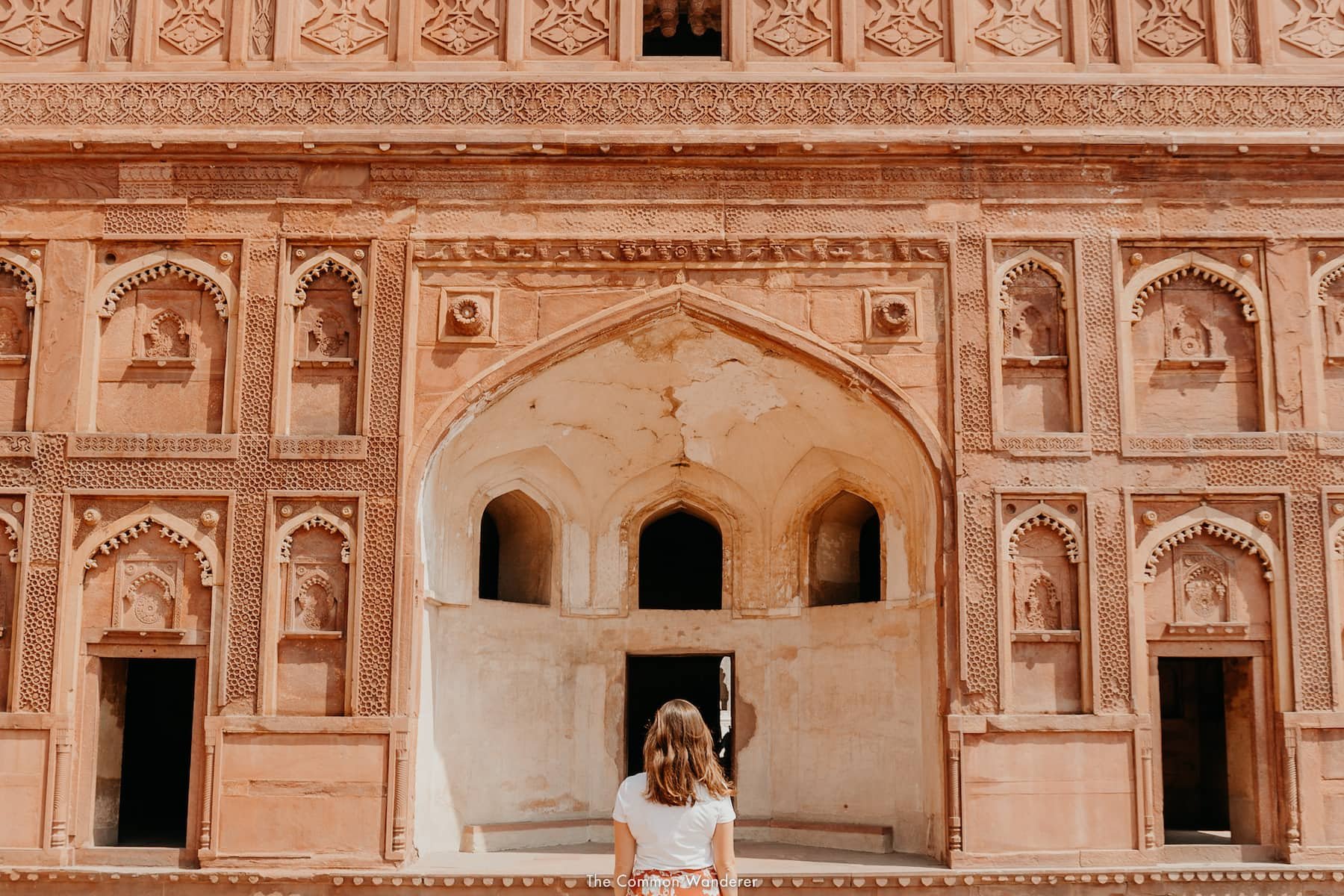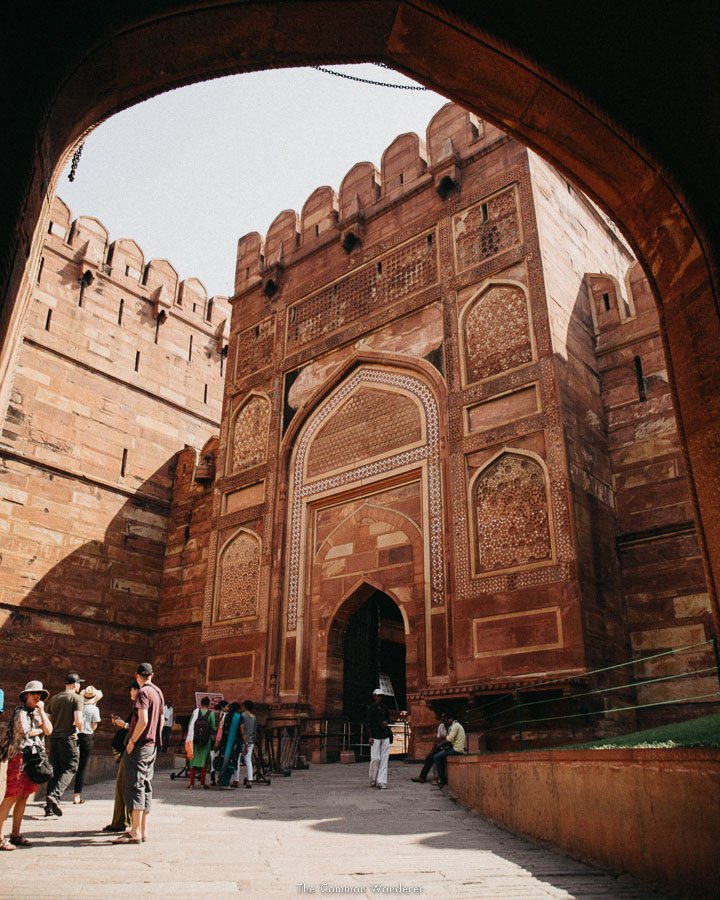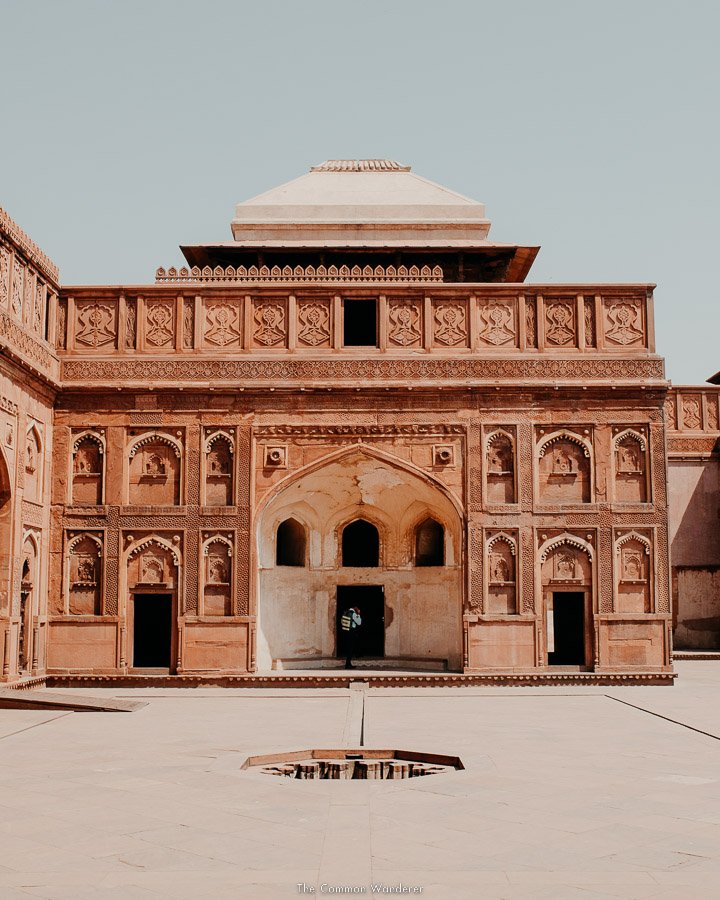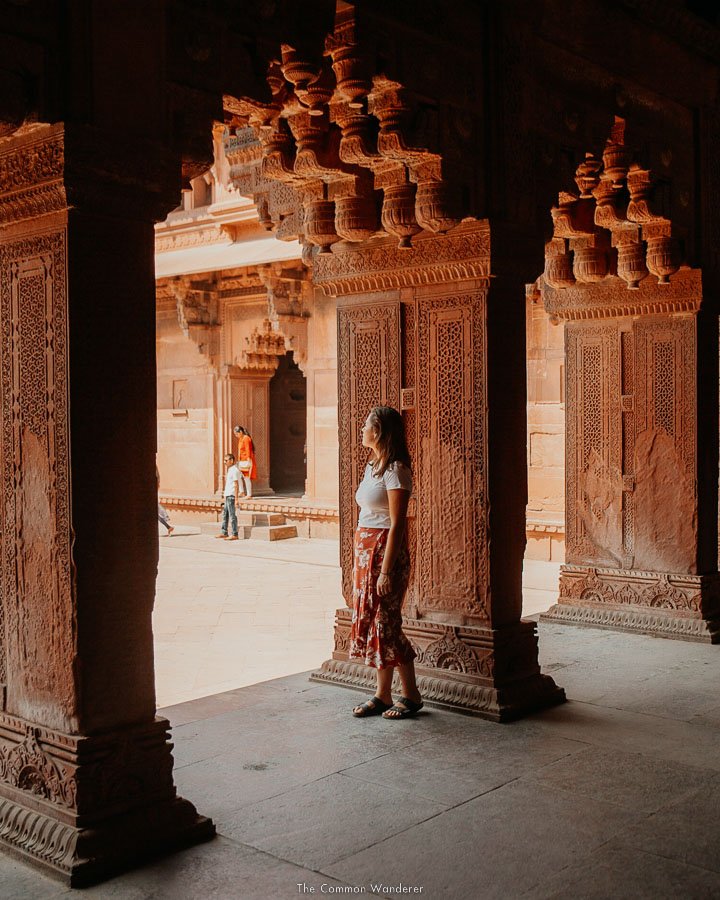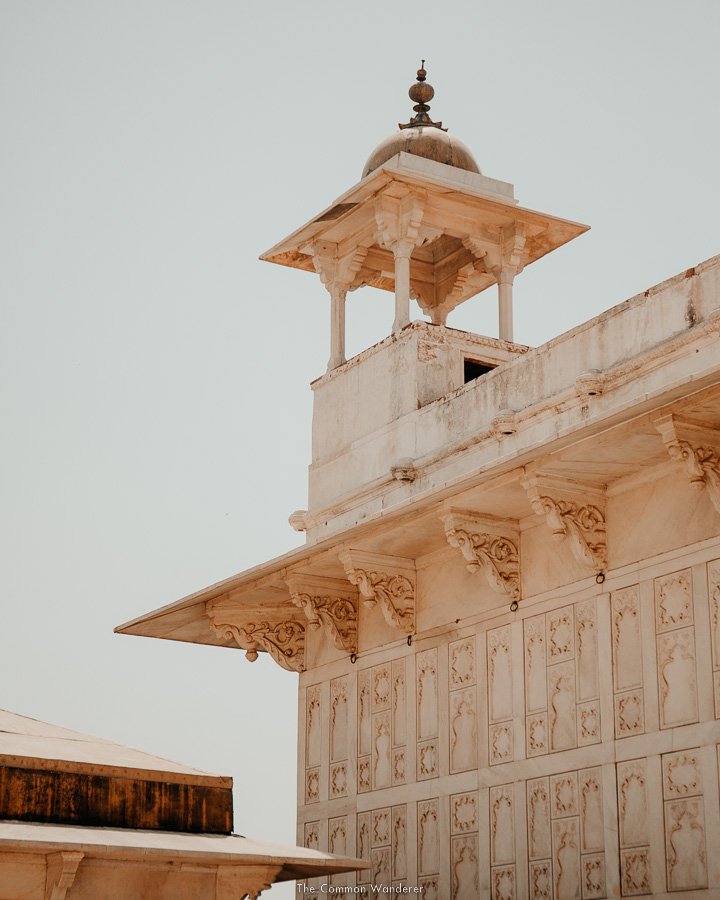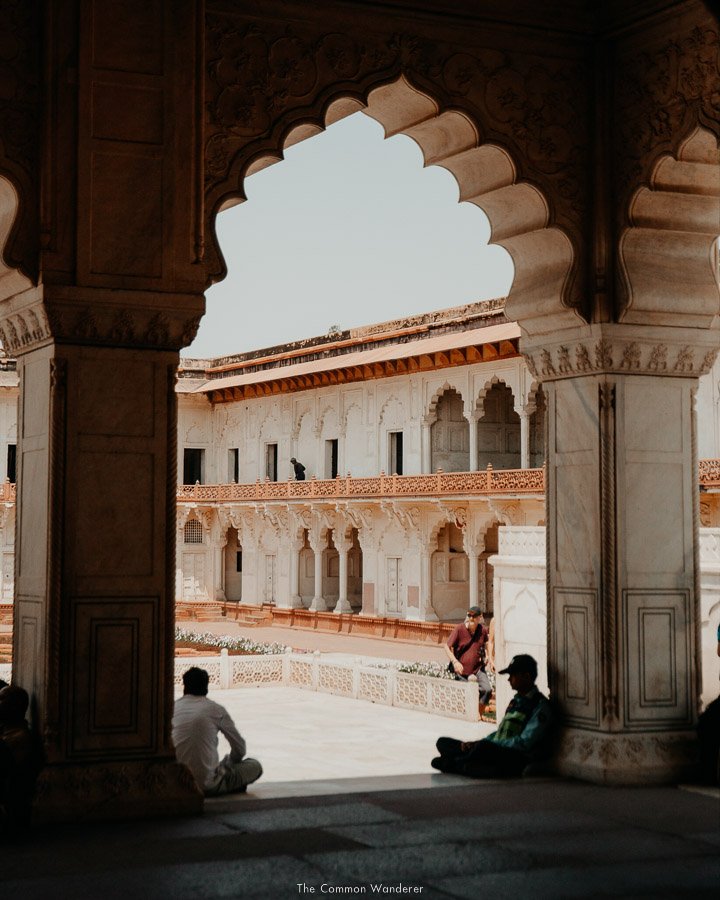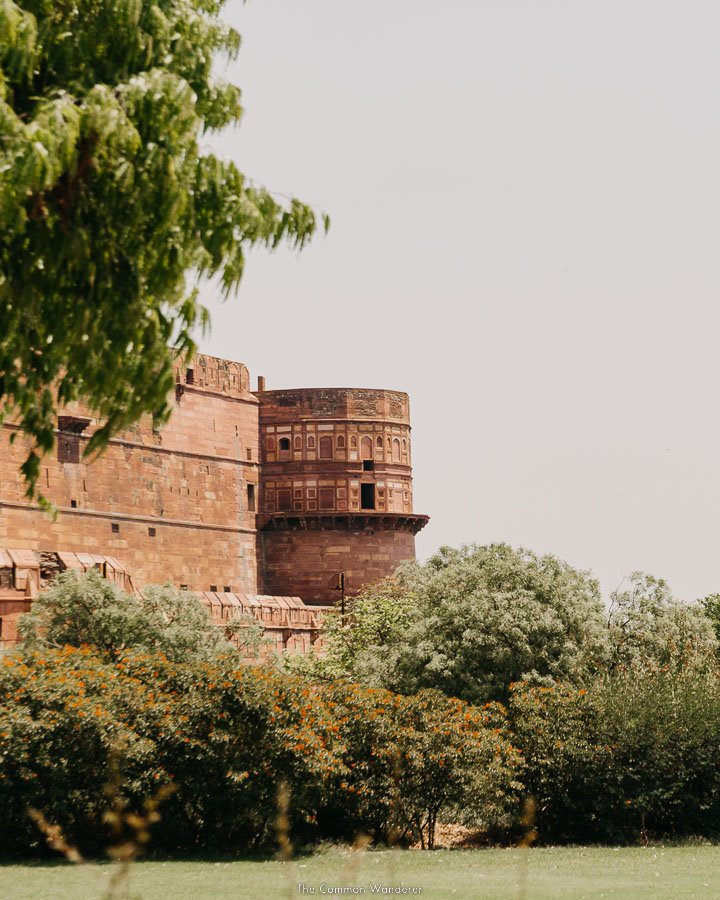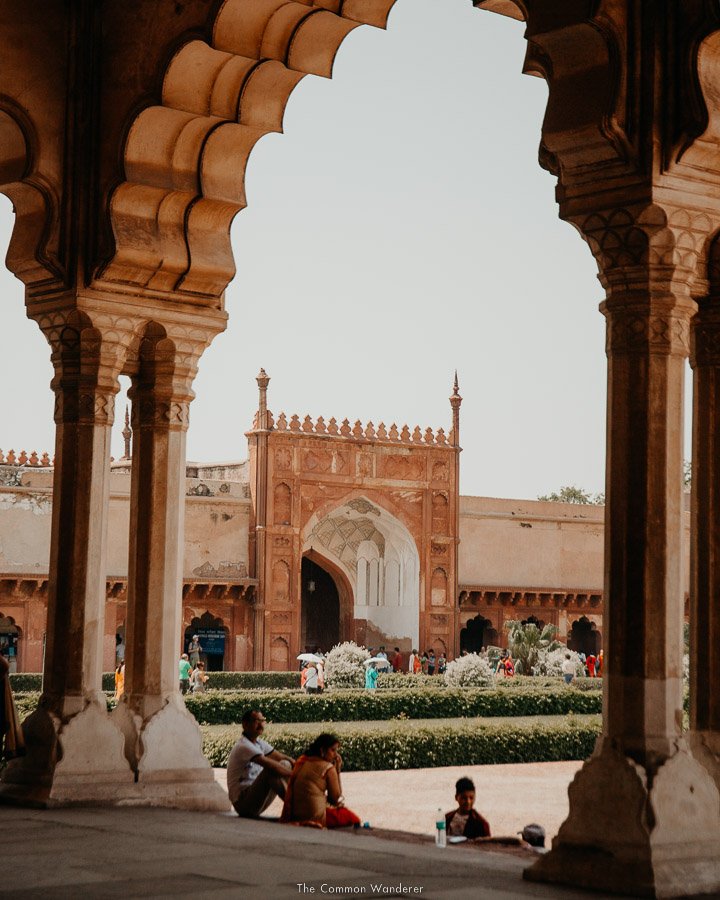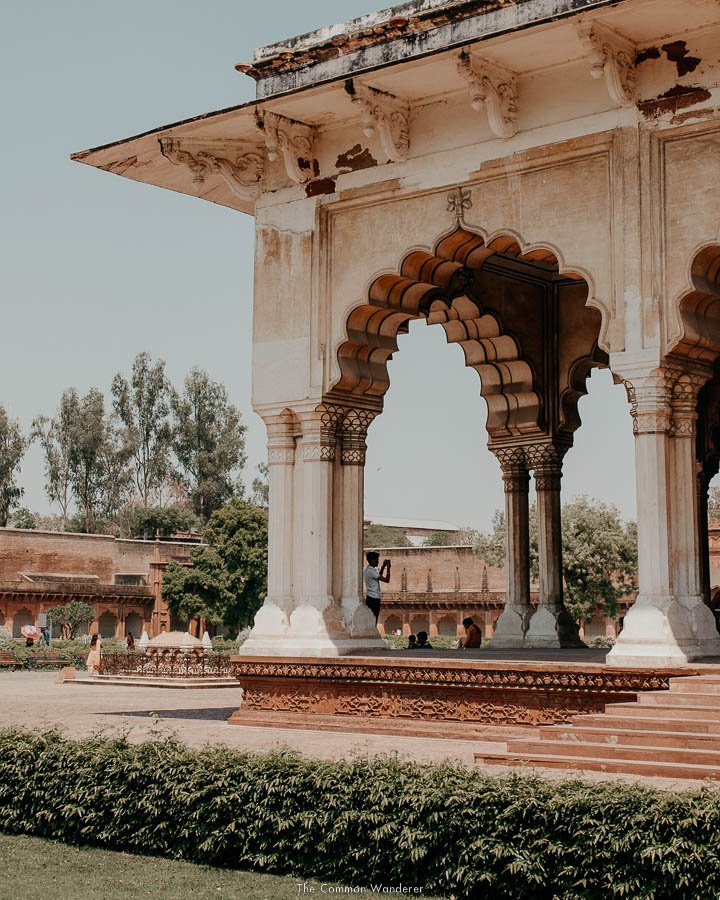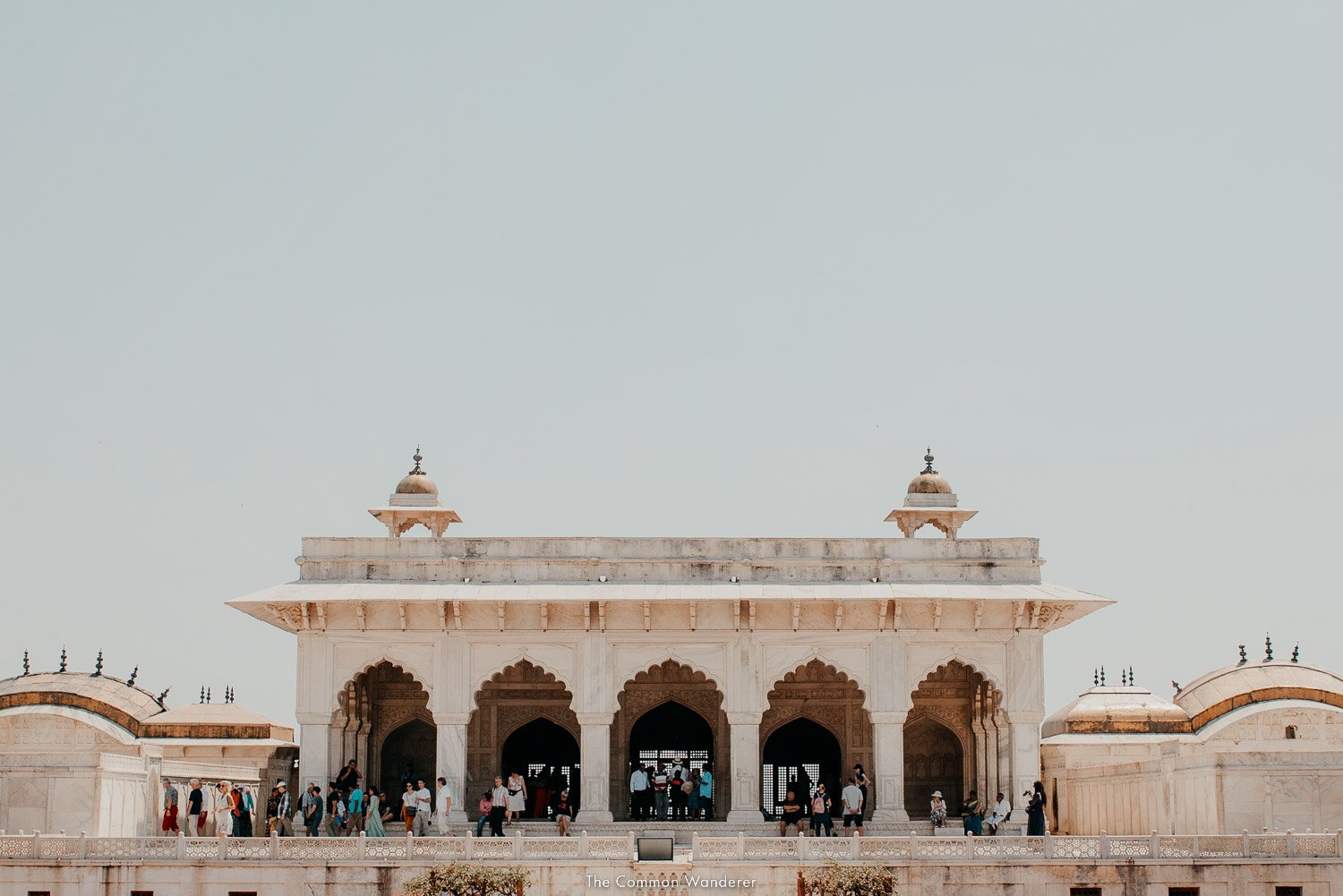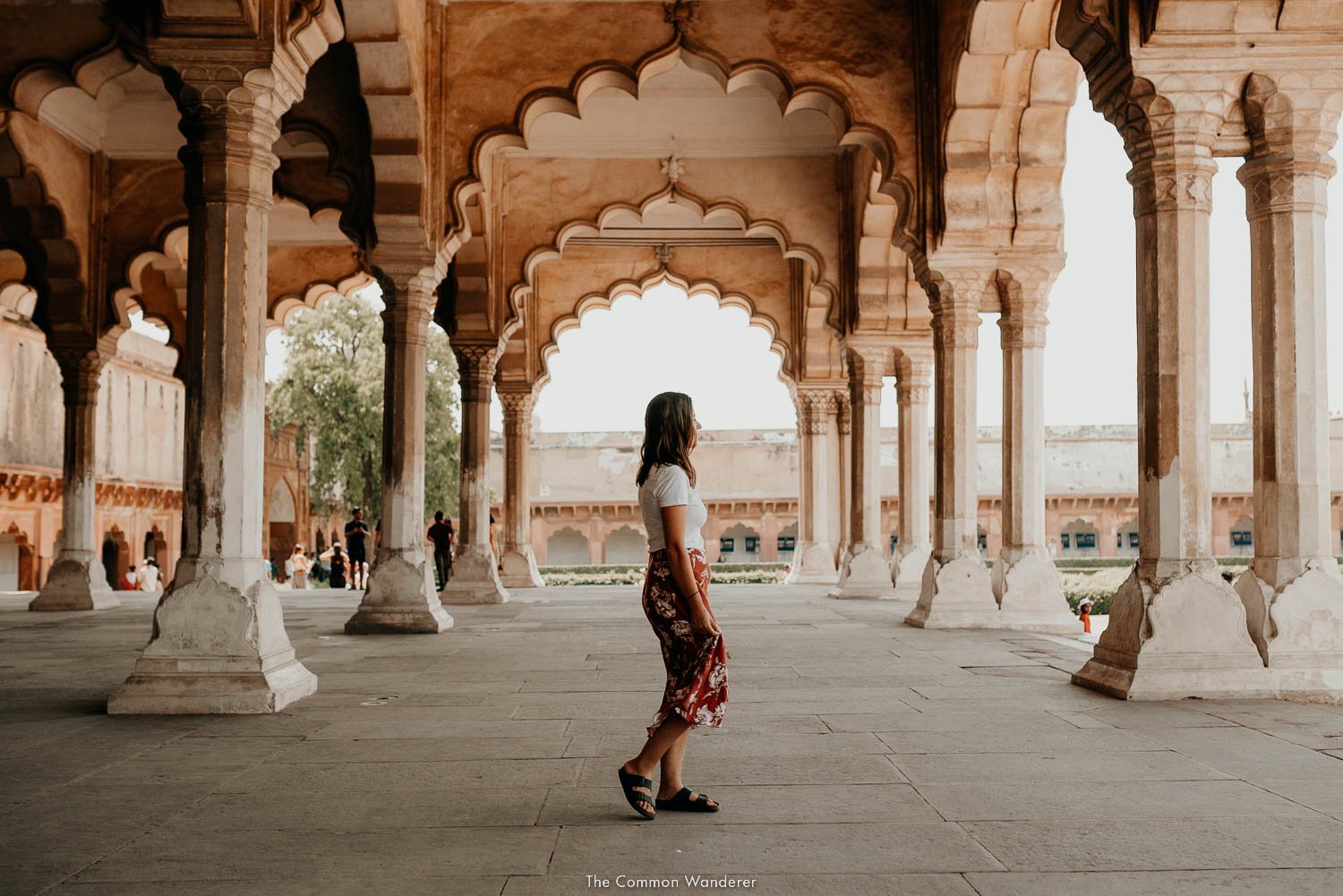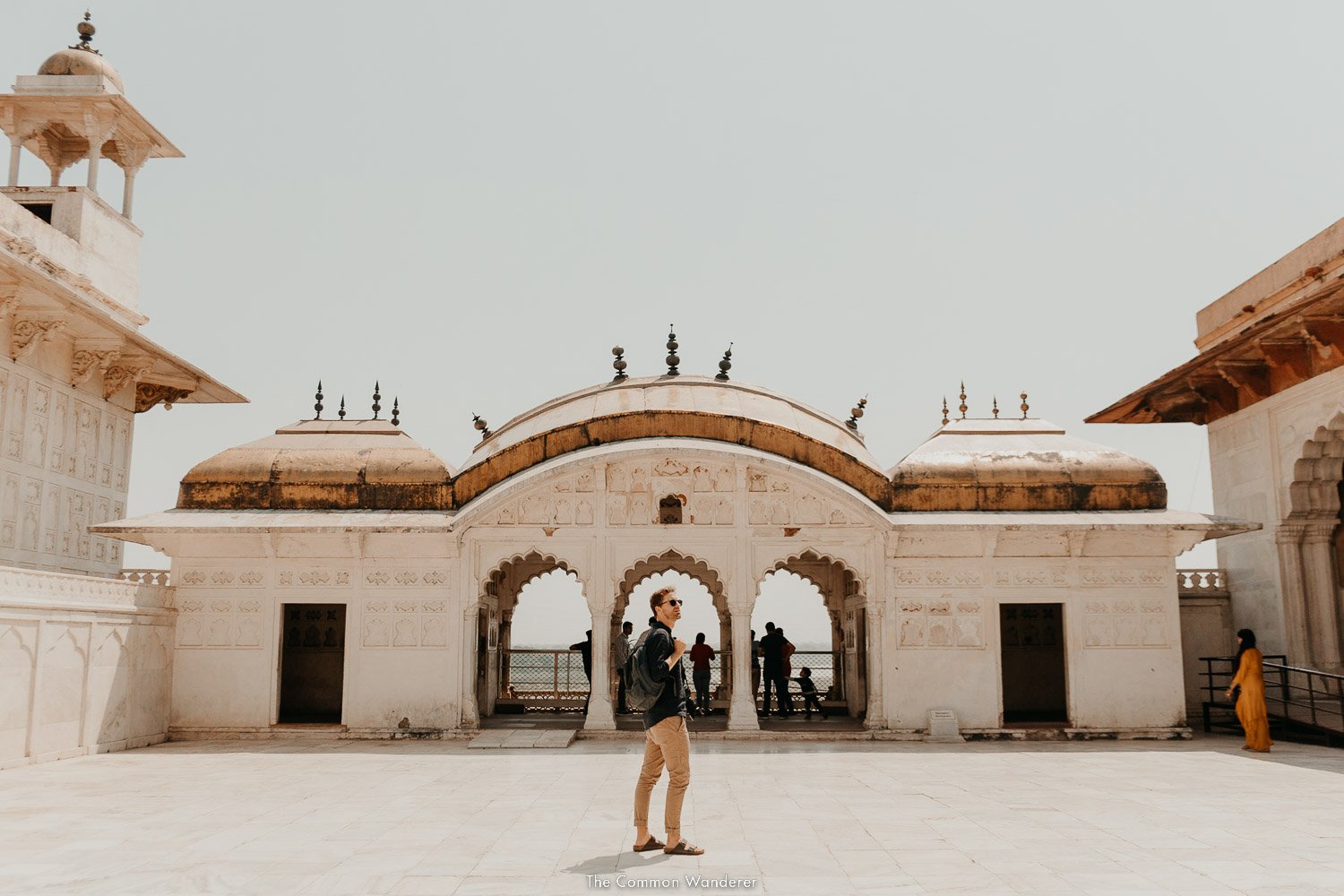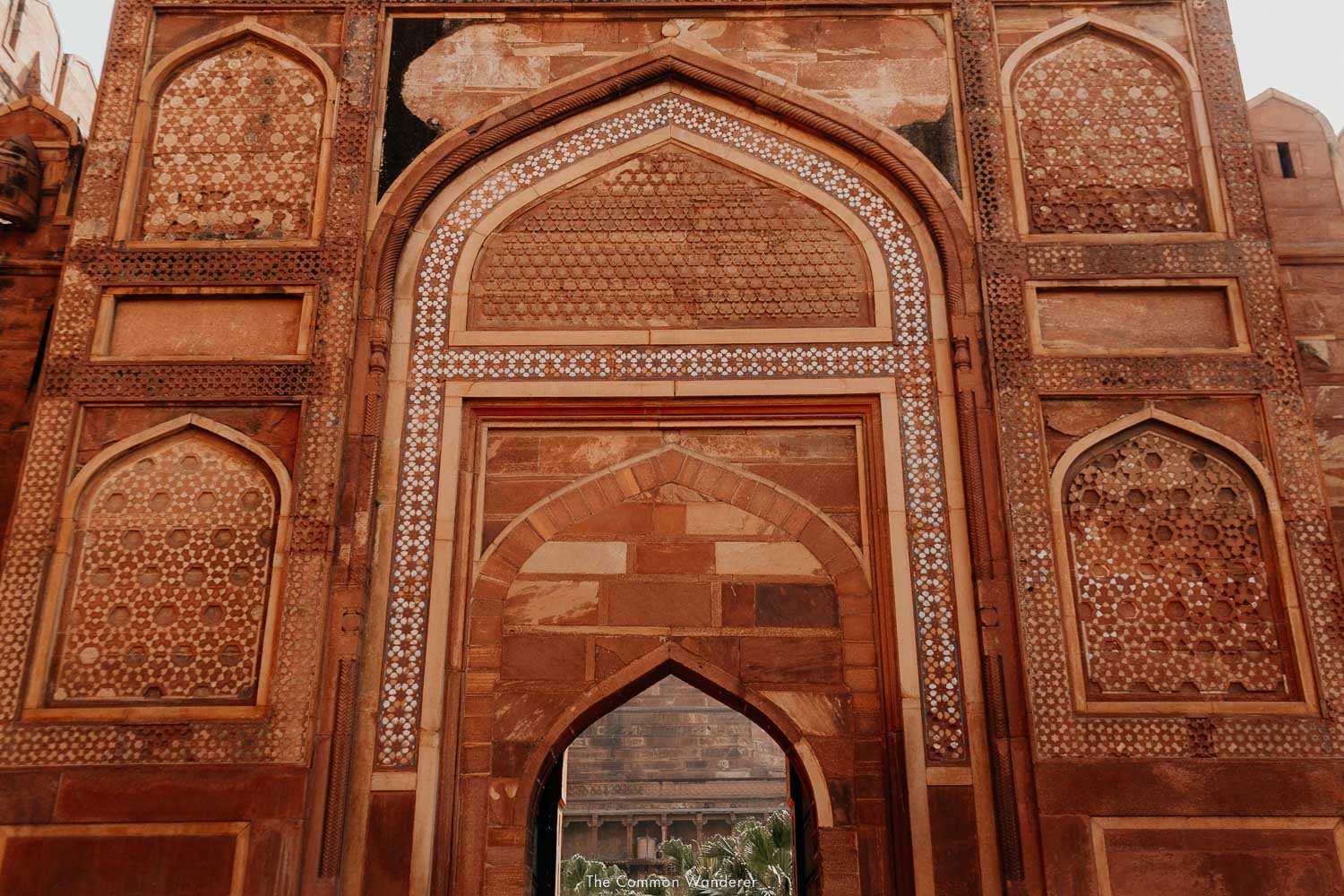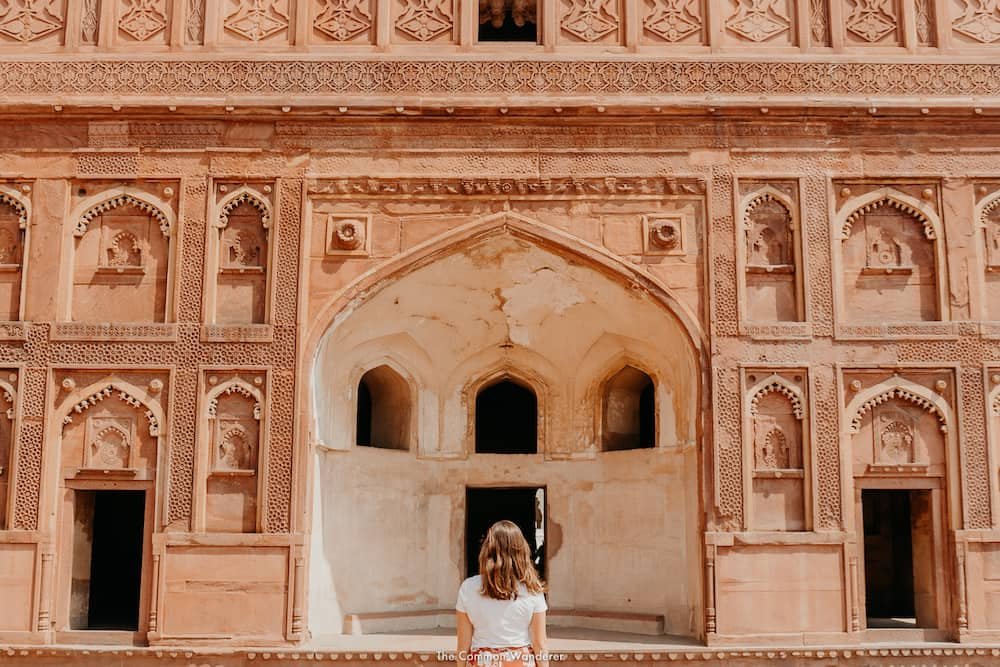How To Visit The Incredible Agra Fort: History, Entry Fees, and How to Get There
Discover the history and architectural beauty of the UNESCO World Heritage Agra Fort. Our guide provides an in-depth look at the fort's fascinating past, stunning features, and tips for making the most of your visit.
We visit Agra Fort in the blistering May heat. Which is something we’d never advise you to do, but we digress.
Sweat drips from our brows as we walk through the imposing, ochre-red Amar Singh gate, and into the storied Fort.
If we’re honest, sightseeing is the last thing on our minds - we’ve seen the overwhelmingly beautiful Taj Mahal this morning, and all we desire right now is a cold drink, and potentially a pool to jump into.
And yet, as we make our way through the incredible 16th-century fort, between courtyard after courtyard of astonishingly beautiful palaces and gardens, it dawns on us that we’re walking in the footsteps of Mughal kings and some of the most important moments in India’s history.
A cold drink and the pool can wait.
Situated on the banks of the Yamuna River and overlooking the Taj Mahal, the UNESCO World Heritage-listed Agra Fort was built during the Mughal era (16th century) and was initially used as a military stronghold before becoming the main residence of the Mughal emperors until the capital was shifted to Delhi.
Built of striking red sandstone and marble, the fort is huge, covering almost 94 acres; its walls and ramparts are imposing, 20m high and stretching for around 2.5km. Its interior is filled with magnificent palaces and gardens, including the Jahangiri Mahal, the Diwan-i-Am, Diwan-i-Khas, Moti Masjid, and the Sheesh Mahal, of which each has its own unique architectural features and historical significance.
A tour through the grounds, learning all about its fascinating history, is an essential thing to do in Agra, and one which we both agree was one of our favourite sites during our time in India.
We’ve created this Agra Fort guide to help you have the same experience as us and to better understand the intricacies and complexities of this incredible structure. From insider tips to essential planning information, we’ll help you enjoy this iconic Indian landmark.
LOVE OUR PHOTOS? Edit like us with our Indian Odyssey preset pack, and Tropical Bliss mobile video filters, inspired by the tropical beauty and colour of this beautiful country
AGRA FORT OVERVIEW
WHERE | Agra Fort, Agra city
WHAT TO SEE | Amar Singh Gate, Jahangir Palace, Shah Jahan Mahal, Diwan-I-Am
ENTRY FEES | INR 550 per person
TOURS | Pre-book your Agra Fort entrance tickets, or this guided tour of Agra Fort
OPENING HOURS | 6 am - 6 pm
HOW TO GET THERE | Taxi, auto-rickshaw, rickshaw or walking
WHO BUILT AGRA FORT? UNDERSTANDING THE HISTORY OF AGRA FORT
To truly understand the beauty and intricacies of Agra Fort, you first have to understand its history. And it’s a history you should know because one of India’s most defining moments happened right here.
In 1565, commissioned by the Rajput King Raja Badal Singh, construction on the fort began. Over the years, fellow Mughal emperors, particularly Emperor Akbar, who made it his main home and military stronghold, extended and remodelled it before the fort was again expanded by Emperor Jehangir, Akbar's son, who built a sprawling palace and a formal garden.
However, it wasn’t until Emperor Shah Jahan took over that most of the incredible buildings you see today were built. He made the most prominent improvements to the fort by constructing a number of opulent palaces and courtyards inside its boundaries, including the Pearl Mosque, which is renowned for its beautiful inlay work, and Jahangir Palace, the fort's most recognisable feature.
When you consider he also constructed the Taj Mahal, among other renowned structures, you begin to realise the man had incredible taste.
It was during this era that Agra Fort had a profound impact on Indian history; the infamous moment when Shah Jahan was imprisoned by his son Aurangzeb and kept there for eight years till his death. Oh, the treachery.
It is said that during this time, Shah Jahan spent his days gazing at the Taj Mahal (which you can also do while visiting the fort), which he had built for his beloved wife Mumtaz Mahal, who is buried there - the Taj was the grandest gesture of love after all.
Today, the Agra Fort is a UNESCO World Heritage Site and a major tourist attraction in Agra, where visitors can explore the fort's palaces, courtyards, and gardens, and admire the intricate architecture and craftsmanship of the Mughal era.
WHAT TO SEE AND DO AT AGRA FORT
AMAR SINGH GATE
After purchasing your entrance tickets just outside the fort walls, you’ll cross over a lovely little moat via a drawbridge, before laying eyes on the imposing gate of Amar Singh.
Be sure to take a moment to gaze at the distinctive, earthy red sandstone walls nearly 22 m high, appreciate the grand octagonal watch towers standing tall on either side of the gate, and indulge in the white marble aesthetics of the inlays adorning the facade (sadly, the beautiful, colourful tiles originally used are now lost).
As you enter through Amar Singh you’ll follow a long ramp flanked by high walls, finally arriving at the heart of the castle!
Amar Singh Gate is one of Agra Fort's four gates. This one is to the south of the complex and is currently the only accessible entrance to the ancient fort. It is said to be the most important gate of Agra city.
The gate was constructed in 1565 - 1573 and was earlier known as Akbar Darwaza Gate, after the Mughal Emperor Abkar who built Agra’s Red Fort. To some, it was also known as Lahore Gate, as its direction faced Pakistan's city of Lahore. Later, it was renamed in honour of Jodhpur’s heroic noble, Amar Singh.
Indian forts are simply nothing without an elaborate gate, and it’s safe to say, Amar Singh is no exception.
JAHANGIR PALACE
Jahangir Palace takes the cake for the most remarkable structure in Agra’s Red Fort.
Also known as Queen Mahal, Jahangir Palace was built in 1570 by Akbar, for his favourite son Jahangir. It also served as a Zenana (women’s quarters), housing the Rajput wives of the Emperor.
Surrounded by beautifully kept gardens, this glorious palace is plastered in red sandstone and licks of yellow dholpur stone. Just outside the entrance, you’ll spot a giant bowl, named Jahangir’s Hauz. This guy was carved out of a single block of stone and was used to keep fragrant rose water inside for bathing.
As you enter through the gateway you’ll be greeted by an internal courtyard, surrounded by stunning stone brackets and cross beams, and encircled by a set of small chambers. There are white marble trimmings, delicate carvings, and traces of beautiful paintings adorning each and every wall and ceiling. Elegance to a T!
Of all the residential buildings in Agra Fort, this beauty is the biggest, prettiest, and most notable of them all. A true highlight!
SHAH JAHAN MAHAL & KHAS MAHAL
Perfectly placed next to Jahangir Palace in the northwest wing of Agra Fort stands the mahal of Shah Jahan. The mighty Emperor was not only Akbar’s grandson but also responsible for building the majestic Taj Mahal. So, you can only imagine how utterly obsessed with white marble architecture he was!
He took his admiration and transformed the once red sandstone palace in 1637, remodelling it entirely with slabs of glistening white marble and topping it off with golden, Bengal-style, domed rooftops.
There are two golden pavilions almost identical in style, both used by Shah Jahan’s daughters, Jaharana and Roshnara (known as Roshan Ara Pavilion).
Nestled between the daughter’s abodes is Khas Mahal, where Shah Mahal himself lived. This mansion features a large hall, rooms, octagonal towers, fountains, elegant gardens and decorative curtain walls (known as ‘sar-i-parda’), surrounding the mahal.
Although the architecture is pretty impressive, the real beauty of this corner of Agra’s Red Fort is the VIEW. My god.
Shining bright in the distance on the other side of the Yamuna river is Agra Fort’s big sister, the Taj Mahal. Head to the terrace or pop your head out of one of the windows for an unobstructed vantage point from within the fort.
ANGURI BAGH
Surrounded by most of the main palaces of Agra Fort lies Anguri Bagh, a sprawling char bagh (quadrilateral garden), once known as ‘The Garden of Grapes’.
Its history began in 1637 when it was first constructed by Shah Jahan for his wife, who was exceptionally fond of wine. The rich harvest of dense grapevines, perfectly manicured flower beds, and hammams (bath houses) situated at the corner, are what made this spot of Agra Fort so special.
This garden was a popular area for the royal ladies to relax and take leisurely strolls.
Nowadays, Anguri Bagh has over 85 symmetrical gardens, a charming fountain, and a reflective pool with scalloped borders, all adding to the alluring grandeur of this place.
DIWAN-E-KHAS
Diwan-E-Khas, or Hall of Private Audience, was built around 1635 and is an important mansion in Agra Fort’s complex. It is here where private meetings and cultural events were held among the rulers and influential guests: such as kings, ambassadors and nobles.
It consists of two large halls: an outer columned hall you see at first glimpse, and an inner closed hall. The latter held the famous Peacock Throne, which was later uprooted to Delhi’s Red Fort in the 18th century.
Overlooking the Yamuna riverside, Diwan-E-Khas has a distinctive marble look, decked out with the most stunning, Persian-style floral motifs, the finest marble pillars, exquisite scalloped archways, and inlays of semi-precious stonework.
TAKHT-E-JAHANGIR
Known as the Throne of Jahangir, this big, black, shiny throne is made of black onyx and was imported by Emperor Jahangir, all the way from Belgium in the year 1602.
It was built in 1605 and was kept at the Allahabad Fort until it was brought here to Agra Fort in 1610.
It is a whopping 3.2 meters long, 2.7 meters broad and 15 centimetres thick! The top of the slab slopes from its centre to the sides like the shell of a tortoise has a hefty crack on one side, and ornate Persian inscriptions in praise of Jahangir, referring to him as Shah and Sultan (king), etched around the stone.
You’ll find this archaeological treasure at Diwan-E-Khas.
THE SHEESH MAHAL (THE GLASS PALACE)
A sparkly palace does no wrong. Artistic walls and ceilings made entirely of intricate mirror mosaics illuminate the room. Yes, please.
Agra Fort’s Sheesh Mahal is located in the northeast corner of the complex, underneath Diwan-E-Khas, and was built between 1634 - 1640. It was once used as the imperial bath for the Queen, thus, it has thick walls to ensure a nice and cool environment.
This place is just gorgeous, and a serious ode to the incredible talent of the Indian craftsmen who built it.
Currently, Sheesh Mahal’s interior is mostly closed off, however, you can still peep in for a good look inside.
MACHCHI BHAWAN
This double-storied building, also known as Fish Palace, once had a large pool at its centre which was filled with gold fishes and marble fountains! The Emperor and Empress used to spend their leisure time at the pool, being entertained by their newfound friends.
The mansions centre has now been replaced with a lovely and spacious grass courtyard and lush green gardens.
On the southern side of the upper storey is a pavilion, featuring a gorgeous sun medallion ceiling carving. This is thought to be where the Emperor would perch on his golden throne, watching over the entire court below.
Take your time wandering the surrounding balconies and admiring the elaborate marble pillars.
DIWAN-I-AM
Pillars on pillars on pillars. Diwan-I-Am, or Hall of Public Audience, is a pillared hall where the Emperor and his successors would hold public meetings with the people and attend to their problems.
This flat-topped, spacious building is a real stunner. Built in 1628, Diwan-I-Am is open on three sides and consists of 48 heavily carved pillars, topped with beautifully engraved arches. Some serious finesse has gone into this one!
With its red sandstone-come-gorgeous marble exterior, this is another fine example of Shah Jahan’s fascination with white marble.
RATAN SINGH KI HAVELI
For 13 long years, Agra’s Red Fort was captured under the rule of the Jat people of Bharatpur, Rajasthan. During the 18th century, they built the Ratan Singh Ki Haveli, as a mansion for themselves their reign.
This striking, rustic red sandstone building is found near the Chattri of Maharaja Jawahar Singh. At its centre is a large courtyard and featured throughout are grand arches, chiselled pillars and lattice windows - all the good stuff.
THINGS TO KNOW BEFORE VISITING AGRA FORT
WHERE IS AGRA FORT, AND HOW TO GET THERE
Agra’s Red Fort is situated along the Yamuna River, in the northern Indian state of Uttar Pradesh, about 230 kms southeast of India’s capital, New Delhi.
A global tourist hotspot, the Taj Mahal, is just 2.5 km from Agra Fort, so reaching from one monument to the other is a breeze. Come out from the West Gate of the Taj Mahal for the shortest ride to the fort.
AUTO RICKSHAW / TAXI
The easiest and most convenient way to reach Agra Fort from where you’re staying in Agra City, or from Agra Cantt Station, is to hail an auto-rickshaw. Most rides should cost you INR 50 to 70.
Alternatively, you can book a taxi (either from the side of the road, through your accommodation, or via the Uber / Ola apps.
WALK
The Taj Mahal is just a short 2.5 km walk away, so if you’re feeling up for it, take a short stroll to Agra Fort.
AGRA FORT TICKETS AND OPENING TIMES
Cost | INR 550 for foreigners plus a separate ticket for ADA Toll Tax upon arrival, which is INR 50 for foreigners. Book your fast-track tickets in advance here
Note | Tour guides line up outside the fort if you would like to hire one, just be sure to check their Government ID’s.
Opening hours | 6 am - 6 pm daily.
Time required | Set aside 2 - 3 hours to explore the fort.
It's also worth noting that Agra Fort is closed on Fridays for visitors. So, plan your visit accordingly.
BOOK | Pre-book your Agra Fort entrance tickets to avoid lines
WHEN IS THE BEST TIME TO VISIT AGRA FORT?
The best time to visit Agra’s Red Fort is early morning or at sunset, to watch the sun's rays glisten through the fort. A photographer's treat!
If you’re only in Agra for a day to see the Taj and Agra Fort, we suggest visiting the Taj for sunrise and the Fort pre-sunset.
The best months for visiting the fort are between October to April. The weather will be pleasing and the sky will be clear. Avoid off-season at all costs (May-August), as the heat in India is hot and humid, and unbearable - trust us, it’s when we visited.
DO YOU NEED A GUIDE FOR AGRA FORT?
It's recommended to book an official guide or take a tour to fully understand the history and significance of the fort.
They can provide you with more information and take you around the fort more efficiently.
To hire a guide or not to hire a guide... this here is completely up to you!
We’ll be upfront and say that we hired a guide, and it was a wonderful experience to gain a greater understanding of this historic structure.
If it’s important for you to hear all the details about the history of Agra Fort, understand the significance, learn facts behind each section of the palace and not get lost in the maze of hallways - then we highly recommend hiring a guide.
In order to do book a guide on site, make your way towards the Agra Fort ticket counter located near Agra Square, in where you’ll find an abundance of official tourist guides lining up.
Do check for a valid ID of your guide before commencing, as the last thing I want is for you to get ripped off! On average a guide for a 1 - hour tour should cost you roughly INR 300 - 500.
Alternatively, exploring the Agra Fort complex is easily done without a guide!
Without a guide, you can take your time and explore every nook and cranny at your own pace, which can be good for photographers.
BOOK | A guided tour of Agra Fort
HOW LONG SHOULD YOU SPEND IN AGRA?
Agra, similar to Delhi, is a place you want to get in, see the sites, and get the hell out of. Apart from the famous historical and cultural monuments, Agra is a crazy, polluted city that lacks the beauty of other places in India, such as Jaipur, Udaipur and Varanasi.
In order to truly enjoy and appreciate the historic sites in Agra we recommend spending at least 2 days in Agra.
Two days should be the very minimum of your stay in the city if you intend to see the Taj Mahal and Agra Fort. The Taj Mahal may be visited in its entirety for one day, and the next day can be used to explore the Agra Fort and other adjacent attractions like the Itimad-ud-Daulah and Akbar's tomb.
If you wish to visit the nearby UNESCO World Heritage Site of Fatehpur Sikri, which is around 40 kilometres to the west of Agra, we suggest staying an extra night in the city.
and is worthwhile to see if you have more time. You can also think about exploring the neighbourhood markets, dining on the cuisine there, and touring adjacent cities like Mathura and Vrindavan.
THE BEST TIME TO VISIT AGRA
We highly suggest avoiding visiting Agra in April and May, when the temperatures are hot, the air humid, and the overall vibe unpleasant.
So when is the best time to visit Agra?
The winter months of October through March are the ideal time. During this period, the weather is pleasant, with mild temperatures and clear skies throughout the day.
Avoid monsoon season altogether, which lasts from July to September.
HOW TO GET AROUND AGRA
Agra is a relatively small city and getting around is relatively easy. Here are a few options for getting around Agra:
AUTO RICKSHAW | Auto-rickshaws are widely available in Agra and they are a convenient and affordable way to get around the city. They can be found at almost every corner, and you can also book them via mobile apps. However, it's important to agree on the fare before getting in, as some drivers may overcharge tourists
TAXI | Taxis are also widely available in Agra and they can be booked through your hotel or through various mobile apps. They are a bit more expensive than auto-rickshaws but can be more comfortable, especially for longer trips
WALKING | Agra is a relatively small city, so walking is also a good option for getting around. Many of the city's main attractions are located within walking distance of each other - just keep your wits about you
TOURIST BUSES | Agra also has a tourist bus service that covers all major tourist spots, including the Taj Mahal, Agra Fort, and the Itmad-ud-Daulah. This is a great option if you want to cover all the major sites in one go
INDIA PACKING ESSENTIALS
Travelling through India comes with a unique set of needs.
To help you have a comfortable, happy journey, we recommend bringing the following items with you:
REUSABLE WATER BOTTLE | THE BEST INVESTMENT WE’VE EVER MADE! We use the Grayl water purification bottles, which allow us to fill up from any water source, anywhere in the world (including train taps!). We used this bottle throughout India without issue
A TOTE BAG | The humble tote is a versatile little lifesaver when on the road. They're plastic-free, small, easily foldable, and can pack a surprising amount! Check out this range of beautifully designed, personalisable totes bags here
BIODEGRADABLE WET WIPES | Keep clean without destroying the planet!
HAND SANITISER | This is not something we’d actually recommend normally, but we now live in Covid times... so this can be a bloody great investment
INTERNATIONAL TRAVEL ADAPTER | You’ll need a European plug to keep your gear going!
POWER BANK | Don’t get caught out without power for your devices
EYE MASK | For those annoyingly early sunrises!
BIO-FRIENDLY TOILETRIES | Avoid damaging and chemical-heavy products and facial scrubs with microbeads altogether. We recommend Lush solid shampoo, conditioner and body wash bars, ocean-friendly sunscreen (Stream2Sea), a mooncup is a great investment for “that” week and Lip balm for the sun
TRAVEL INSURANCE | STAY SAFE IN INDIA
If you can't afford travel insurance, you really can't afford to travel. As the current global situation has taught many people, things can go wrong anywhere in the world - and insurance is often the only way of mitigating any issues with minimal expense or stress for you.
Here are our recommendations, based on 8+ years of full-time travel:
FOR TRAVELLERS | HeyMondo - COVID-19 coverage, comprehensive travel + medical insurance, an app with 24-hour medical support, and no out-of-pocket fees. *Get 5% off your policy by booking through our link here.
FOR DIGITAL NOMADS | SafetyWing - COVID-19 coverage, comprehensive travel & medical, and policies can be purchased while already abroad.
CAR INSURANCE | Insurance4CarHire - a great annual car insurance policy
EXPERIENCE THE BEST OF INDIA
THE BEST OF JAIPUR | Experience the best things to do in Jaipur, Where to stay in Jaipur, Our detailed guide to Amer Fort, our guide to the City Palace Jaipur, A guide to the stunning Hawa Mahal, How to visit Nahargarh Fort
UDAIPUR | The top places to visit in Udaipur
BUNDI | Explore the unexpected beauty of Bundi
INDIA ITINERARY | Our detailed three-week India Itinerary, Everything you need to know before catching trains in India
COWS, CURRIES AND COLOUR | A must-read from our three weeks travelling India by train
PHOTOGRAPHY | Click here to view our detailed photography gear guide, as well as our top travel photography tips!
PRESETS | Buy out exclusive Lightroom presets for Mobile
RESPONSIBLE TRAVEL | Responsible travel is important. REALLY IMPORTANT. Learn our top responsible travel tips to help you, your family and your friends travel more consciously around the globe
ECO-FRIENDLY PACKING ESSENTIALS | Don’t leave home without our favourite eco-friendly travel essentials
PLAN YOUR TRIP TO INDIA WITH THESE POSTS!
Article written by Briar Jones: Briar is a free-spirited Kiwi traveller, creative graphic designer, illustrator and dabbler in photography. She’s spent her entire adult life solo backpacking around the world, having now found a home in India, her favourite place on earth. She’s a lover of a good roadie through the mountains, music flowing, with her camera in hand.
You can follow along with her adventures on Instagram @briarashleigh.
Some of the links on this Agra Fort Guide are affiliate links.
If you choose to purchase using these links, we receive a small commission at no extra cost to you. Please know that by using these affiliate links, you're directly supporting The Common Wanderer to stay wandering, the running costs of the site, and our ability to provide you with free content to help you on your travels.
That, and you're officially a legend.

